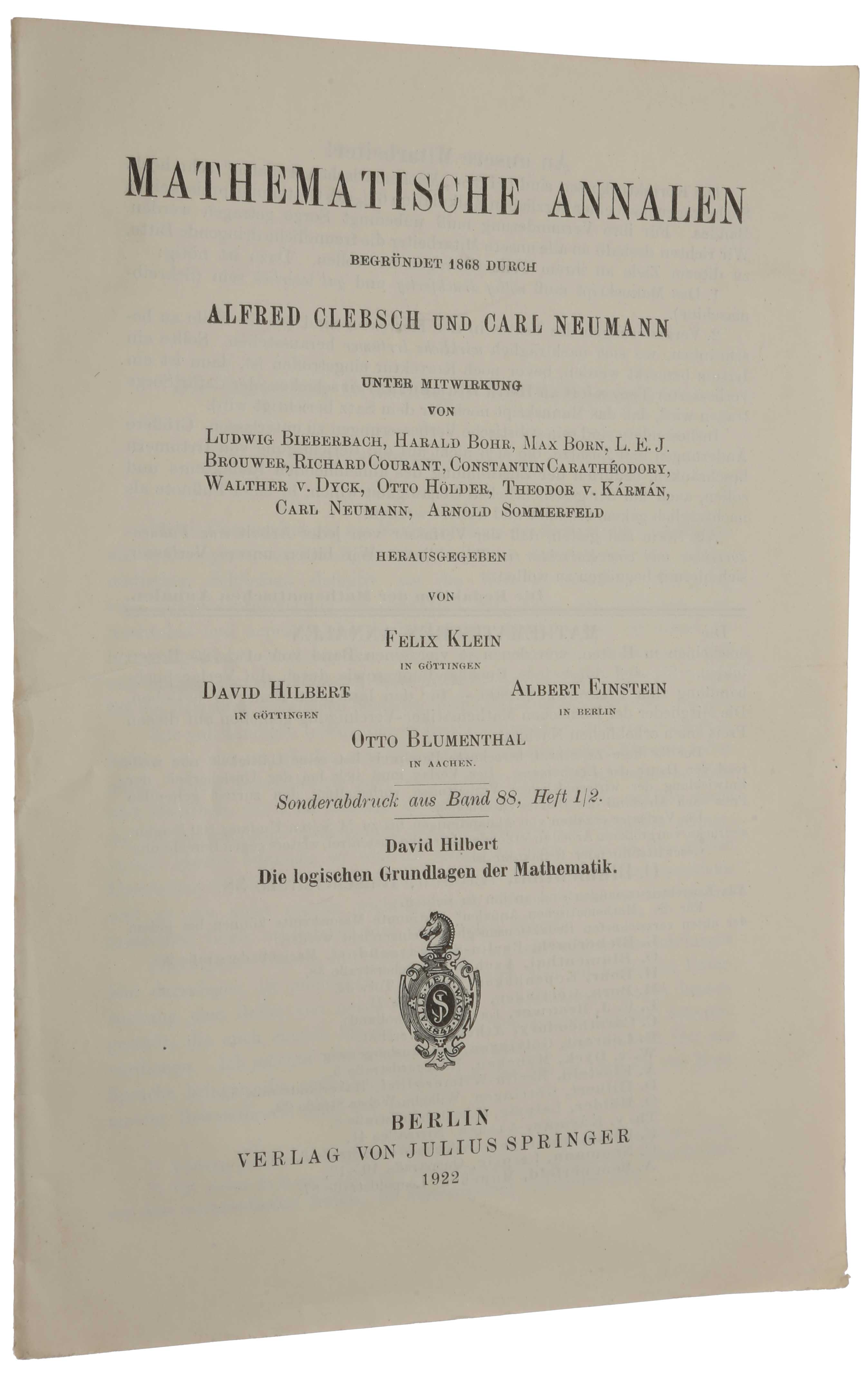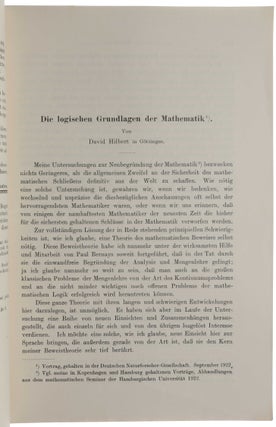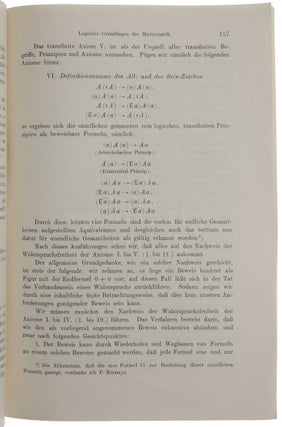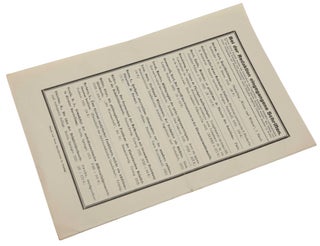Die logischen Grundlagen der Mathematik.
Berlin: Julius Springer, 1923.
First edition, the extremely rare author’s presentation offprint issue, of the second major paper in the development of the 'Hilbert programme.' Based upon a lecture given at Leipzig in September 1923, it is the sequel to Hilbert's Neubegründung der Mathematik (1922), in which Hilbert had put forward his proposal for a foundation for all of mathematics based on axiomatics and logic. “Hilbert sketched in his Leipzig talk of September 1922, which was published as [the present paper], the consistency proof [for arithmetic]. However, the really dramatic aspect of his proof-theoretic discussion is the treatment of quantifiers with the τ-function … Hilbert extends the consistency argument then to the ‘first and simplest case’ that goes beyond the finitist system … It is only in the Leipzig talk that Hilbert gave proof theory its principled formulation and discussed its technical tools – for the first time outside of Göttingen. As far as analysis is concerned, [he proves]: i) the least upper bound principle for sequences and sets of real numbers, ii) Zermelo’s choice principle for sets of sets of real numbers … He ends the paper with the remark: ‘Now the task remains of precisely carrying out the basic ideas I just sketched; its solution completes the founding of analysis and prepares the ground for the founding of set theory’” (Sieg, p. 135). OCLC locates the copy at the Universitätsbibliothek Hamburg only.
Hilbert’s work on the foundations of mathematics has its roots in his work on geometry of the 1890s, culminating in his influential Grundlagen der Geometrie (1899). Hilbert believed that the proper way to develop any scientific subject rigorously required an axiomatic approach, which would enable the theory to be developed independently of any need for intuition, and would facilitate an analysis of the logical relationships between the basic concepts and the axioms. Hilbert realized that the most important questions are the independence and the consistency of the axioms. For the axioms of geometry, consistency can be proved by providing an interpretation of the system in the real plane, and thus the consistency of geometry is reduced to the consistency of analysis. The foundation of analysis, of course, itself requires an axiomatization and a consistency proof. Hilbert provided such an axiomatization in Über den Zahlbegriff (1900), but it became clear very quickly that the consistency of analysis faced significant difficulties, in particular because the favoured way of providing a foundation for analysis in Dedekind’s work relied on dubious assumptions akin to those that lead to the paradoxes of set theory. Hilbert thus realized that a direct consistency proof of analysis, i.e., one not based on reduction to another theory, was needed. He proposed the problem of finding such a proof as the second of his 23 mathematical problems in his address to the International Congress of Mathematicians in 1900 and presented a sketch of such a proof in his Heidelberg talk Über die Grundlagen der Logik und der Arithmetik in 1905, but further progress was delayed because of the lack of a properly worked-out logical formalism.
The publication of Russell and Whitehead’s Prinicpia Mathematica provided the required logical basis for a renewed attack on foundational issues. In September 1917, Hilbert delivered an address to the Swiss Mathematical Society entitled Axiomatische Denken, his first published contribution to mathematical foundations since 1905. In it, he again emphasizes the requirement of consistency proofs for axiomatic systems, and states his belief that this had been achieved by Russell’s work in Principia. Nevertheless, other fundamental problems of axiomatics remained unsolved, including the problem of the “decidability of every mathematical question,” which also traces back to Hilbert’s 1900 address.
Within the next few years, however, Hilbert came to reject Russell’s logicistic solution to the consistency problem for arithmetic. At the same time, Brouwer’s intuitionistic mathematics gained currency. In particular, Hilbert’s former student Hermann Weyl converted to intuitionism. Weyl’s paper Über die neue Grundlagenkrise der Mathematik (1921) was answered by Hilbert in three talks in Hamburg delivered on July 25-27, 1921, published as Neubegründung der Mathematik. In that paper, “Hilbert sets out the basic ideas of his proof theory, describes a simple formal axiom system for a fragment of arithmetic, and proves its consistency; he also lays the groundwork for his later investigations of the foundations of set theory and real analysis ... Hilbert makes no attempt to supply a consistency proof for the transfinite part of his theory” (Ewald, p. 1116).
“[Die logischen Grundlagen der Mathematik], delivered as a lecture to the Deutsche Naturforscher Gesellschaft in Leipzig, September 1922, is a sequel to
[Neubegründung der Mathematik], and brings Hilbert’s proof theory to maturity. Hilbert here introduces several technical refinements and clarifications to his theory. Specifically: (i) He improves the formal system by adding a special sign for negation. (ii) He refines his account of the distinction between the formal language and the metalanguage; in particular, he now distinguishes clearly between the modes of inference that are permissible in each. In the metalanguage, one operates with a finite logic, that is, a logic dealing with finite totalities; but in the formal language the modes of inference are more powerful. In §§13-15 Hilbert identifies the application of the quantifiers to infinite totalities as the precise point where traditional mathematics departs from finite logic. (iii) He outlines a consistency proof for an elementary, quantifier-free formal system of number theory. (iv) He begins to extend his proof theory to analysis and set theory, and at the end of the paper he sketches a strategy for proving the consistency of a version of Zermelo’s axiom of choice for real numbers. (v) To handle the transfinite parts of mathematics, he introduces a special operator τ on predicates... The τ-operator (which Hilbert and Bernays soon replaced by its better-known dual, ε) also allowed Hilbert to eliminate quantifiers from his formal language: they are replaced by the ε-operator, which is governed by the single transfinite axiom. This greatly simplifies the proof theory. For a formalized proof then consists solely of substitutions and of applications of the sentential calculus. Hilbert’s strategy for proving consistency was this: to replace the (finitely-many) ε-terms in any proof by successively assigning numerical values to them in an effective manner. The hope was that this procedure could be shown to terminate in a finite number of steps, leaving behind only unobjectionable, quantifier-free formulae” (Ewing, pp. 1134-5).
W. Ewald, From Kant to Hilbert, Vol. II, Oxford, 1996; W. Sieg, Hilbert's Programs and Beyond, Oxford, 2013.
Offprint from Mathematische Annalen, Bd. 88. 8vo, pp. 151-165. Original printed wrappers.
Item #4475
Price: $3,200.00





